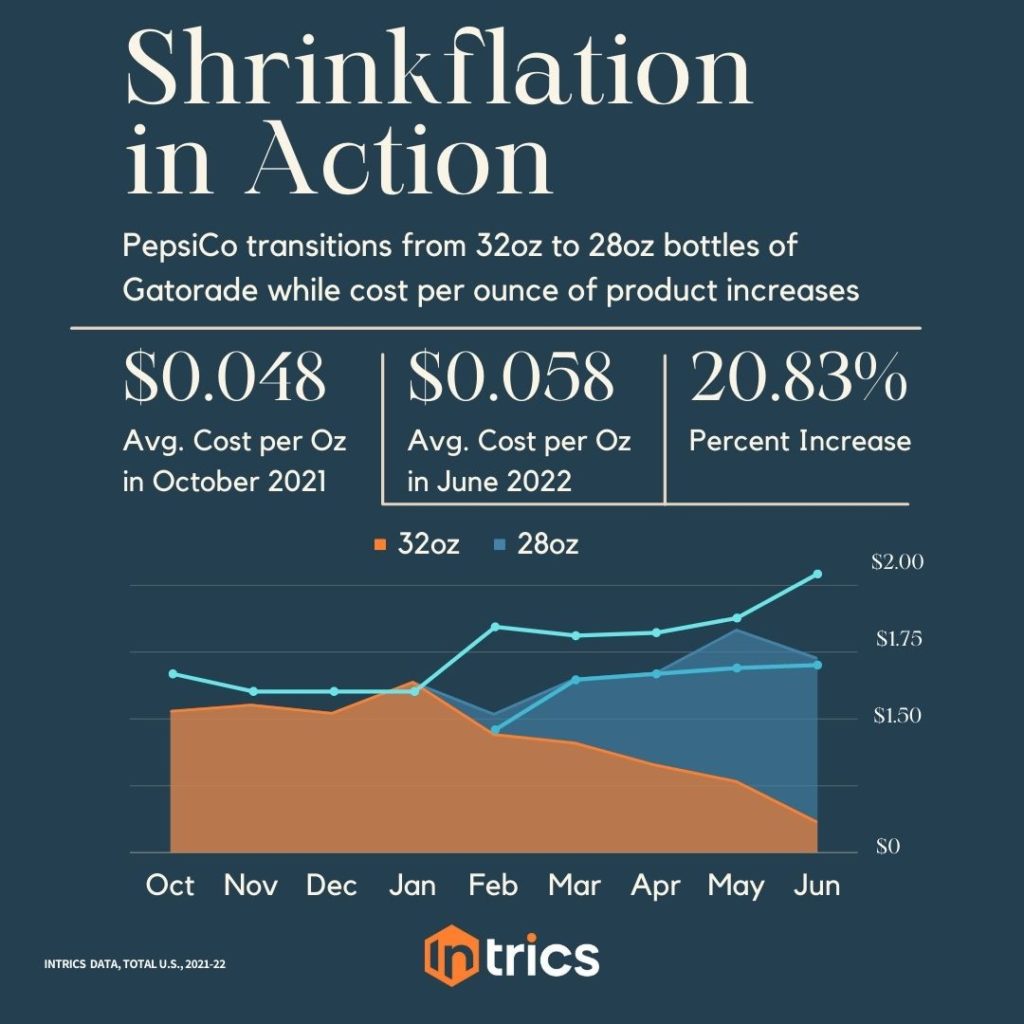
Key Points
- “Shrinkflation” is the term used to describe the practice of CPG companies charging the same amount for less product
- Companies utilize shrinkflation as a subtle way of passing along costs to the consumer
- Cost per volume of product increases in a way that is often difficult for both retailers and consumers alike to notice
What is Shrinkflation?
“Shrinkflation” has become a popular topic on social media platforms such as TikTok lately. Garnering approximately 250 million views, creators are sharing examples of the changes popular brands have made to their products due to increasing costs of goods and transportation.
The term is when CPG companies reduce the size of their products while increasing the net price per unit. Overall, consumers tend to pay more attention to the price tag as they look to stretch their grocery budgets. Without directly changing the sticker price on store shelves, shrinkflation passes along the cost of inflation to the consumer and allows companies to maintain sales figures while increasing profit margins. Across the country, no common household item is immune, affecting everything from ice cream to toilet paper.
CPG companies aren’t necessarily hiding that they’re doing this, either. In recent remarks about their second quarterly earnings report for 2022, PepsiCo openly acknowledged that they are utilizing shrinkflation. CEO Ramon Laguarta stated that the company was sharpening its revenue management capabilities with “mix and match assortment solutions.” Similarly, CFO Hugh Johnston indicated that they were exploring reducing product volumes “rather than increasing prices.”(FoodDive)
In March 2022, Quartz.com noted that PepsiCo had already introduced a 28oz version of Gatorade to replace its 32oz bottle.
Data Review
Curious to see how quickly—and to what effect—shrinkflation is taking over grocery store shelves, Intrics reviewed data collected from grocery stores nationwide. From October 2021 through June 2022, we followed one of PepsiCo’s popular sports drinks, Gatorade. Our goal was to see how the company has changed its product pricing and assortment using shrinkflation methods.
In October 2021, Gatorade’s popular ‘Cool Blue’ flavor had an average price point of $1.59 for their 32oz bottle. The price point dropped slightly—potentially in anticipation of shrinkflation—to $1.53 from November 2021 into January 2022. In February, PepsiCo introduced the 28oz bottle into the market. As the 28oz bottle gained momentum in the market, it replaced the 32oz bottle’s previous consumer price of $1.42. Meanwhile, as PepsiCo moved to phase out the 32oz botte, we noted a significant price increase to $1.76.

The takeaway: in nine months, PepsiCo raised the price per ounce of Gatorade by 20.8%, approximately double the 10.9% rate of inflation reported over the past year. (U.S. Bureau of labor statistics)
Why Is Shrinkflation Important for Retailers and Competitors?
A new survey from Morning Consult shows that almost two-thirds—64%—of adults report being concerned about shrinkflation. As a result, they are becoming more net-value conscious than they have been in the past. 49% of consumers report purchasing from a competing brand while 48% say they opted for private-label versions when available. 33% report purchasing in bulk rather than smaller unit packages. Only 19% of consumers who report noticing inflation say that they haven’t changed their shopping habits. This means four in five shoppers are looking for less expensive alternatives, making them more open to purchasing new products.
On the whole, retailers can expect to see a shift in their customers’ shopping patterns as the cost of food continues to rise. Retailers and competitors have a valuable opportunity to take advantage of changing market demands by updating their product assortment and market strategies and promoting less expensive alternatives to popular goods.
Intrics provides insights and clarity by analyzing 7.6 million prices across 25 of the country’s leading grocers nationwide. By considering national brands and private-label alike, and linking disparate SKUs and descriptions to a single UPC, Intrics provides product-level indexes in your markets. This allows you to be the first to react by quickly understanding changes to product prices, whether your competitors are absorbing or forwarding increased costs to consumers, as well as how your prices and price changes compare to theirs.
Learn more about how Intrics can discover insights for your local market.
